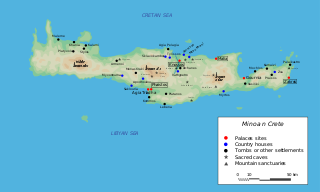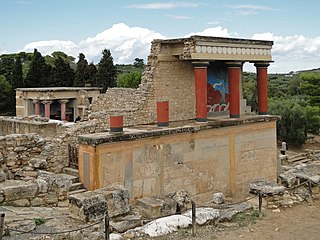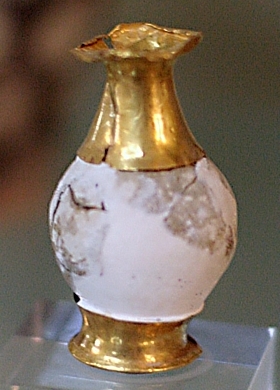
Vasiliki is the name of a village in the municipality of Ierapetra, in the prefecture of Lasithi, on Crete, and the name of the nearby Minoan archeological site. The site took its name from the village.

Vasiliki is the name of a village in the municipality of Ierapetra, in the prefecture of Lasithi, on Crete, and the name of the nearby Minoan archeological site. The site took its name from the village.
Vasiliki lies on a small hill in the north of the Ierapetra isthmus. [1] It is located about 2 km inland from the north coast of Crete and the Mirabello Bay. The nearby archaeological site of Priniatikos Pyrgos is about 7 km to the north-west.
The exit of the impressive Ha Gorge is located nearby.

Vasiliki was first excavated 1903-1906 by American archaeologist R. B. Seager. Nicolas Platon continued excavations in 1953. In 1970, A. A. Zois began meticulous work that lasted until 1982, and returned to the site again in 1990 to continue the work.
The Minoan village was in use from EMIIA to LMIA. The first structures were constructed during EM IIA period. These buildings were destroyed and new buildings went up during EM IIB.
From about 2500 BC onwards, the culture of Vasiliki resembled art elements as other Cretan sites such as Knossos and Trapeza based upon pottery finds. [2] A nearby tomb from LMIII was once discovered, but the location has not been rediscovered.
The site includes houses, many Vasiliki-ware pottery finds and a paved courtyard.
The distinctive pottery found at this site and named Vasiliki Ware is not unique to Vasiliki. It was also produced at several other sites and widely distributed elsewhere.
The first examples of Vasiliki Ware are to be found in East Crete during EM IIA period, but it is in the next period, EM IIB, that it becomes the dominant form among the fine wares throughout eastern and southern Crete. [3]
There's another important archaeological site nearby, Priniatikos Pyrgos, roughly contemporary with Vasiliki. It contains many examples of Vasiliki ware.

The Minoan civilization was a Bronze Age culture which was centered on the island of Crete. Known for its monumental architecture and its energetic art, it is often regarded as the first civilization in Europe.

Knossos is a Bronze Age archaeological site in Crete. The site was a major center of the Minoan civilization and is known for its association with the Greek myth of Theseus and the minotaur. It is located on the outskirts of Heraklion, and remains a popular tourist destination.

Myrtos is a coastal village in the west of the municipality of Ierapetra, in the Regional Unit of Lasithi on the Greek island of Crete. It is located 50 km (31 mi) from Agios Nikolaos and 15 km (9.3 mi) from Ierapetra, on the road to Viannos. A little to the west of the village is the iconic conical Kolektos mountain. Myrtos is situated on the Libyan Sea. The patron saint of the village is Saint Anthony. The population of the village in 2010 was approximately 600 people.

Pyrgos is an archaeological site of the Minoan civilization near Myrtos in the municipality of Ierapetra on the south coast of Crete. Pyrgos provides evidence of settlements along the southern Ierapetra Isthmus. This site has had a long history due to its valuable location and geography. It is located close to the Myrtos valley and has a harbor with a nearby mountain range providing its protection. The settlement includes a courtyard, many rooms, a country house and a tomb.



Minoan pottery has been used as a tool for dating the mute Minoan civilization. Its restless sequence of quirky maturing artistic styles reveals something of Minoan patrons' pleasure in novelty while they assist archaeologists in assigning relative dates to the strata of their sites. Pots that contained oils and ointments, exported from 18th century BC Crete, have been found at sites through the Aegean islands and mainland Greece, on Cyprus, along coastal Syria and in Egypt, showing the wide trading contacts of the Minoans.

Kamares is a village in south-central Crete, Greece. It is the location of an archaeological site of a Minoan sacred cave. The sacred cave at Kamares is slightly offset from a saddle in the Psiloriti Range virtually aligned with the location of nearby Phaistos. Some of the best examples of Middle Minoan pottery have been recovered from the Kamares cave. Kamares has provided the type name for Kamares ware, a ceramic type dating from MM IA, or the First Palace Period. This pottery is a light-on-dark polychrome ware, with forms including jugs and cups.

Mochlos is a modern, populated, and inhabited island in the Gulf of Mirabello in eastern Crete, and the archaeological site of an ancient Minoan settlement. There is evidence that Mochlos was not an island in Minoan times, but was attached to the mainland and acted as an eastern harbor.

Phourni is the archaeological site of an ancient Minoan cemetery in Crete, established in 2400 BC and lasted until 1200 BC. Phourni is Greek for "furnace, oven" and the name of the hill on which the cemetery is located. Phourni is located at 70100 Epano Archanes, Heraklion, Greece—located on a hill in north-central Crete. Phourni can be seen from Mount Juktas. It is a small hill situated northwest of Archanes, between Archanes and Kato Archanes. Phourni is reachable from a signed scenic path that starts at Archanes. It was an important site for Minoan burials. The burials consistently and proactively engaged the community of the Minoans. The largest cemetery in the Archanes area was discovered in 1957 and excavated for 25 years by Yiannis Sakellarakis, beginning in 1965. The 6600 sq m cemetery includes 26 funerary buildings of varying shapes and sizes. The necropolis of Phourni is of primary importance, both for the duration of its use and for the variety of its funerary monuments. All the pottery and much of the skeletal material was collected, unlike many other pre-palatial tombs. The cemetery was founded in the Ancient Minoan IIA, and continued to be used until the end of the Bronze Age. The occupation reached its peak during the Middle Minoan AI, just before the palaces of Knossos and Malia appeared. The proximity of Archanes to the important religious centres of Mount Iuktas probably contributed to the prominence of the site.


Vasiliki wares are a distinctive type of Minoan pottery produced in Crete during the Minoan period, named for the finds around the town of Vasiliki, Lasithi, although it was produced at other sites too. The vases include a reddish-brown wash applied unevenly to mimic stone vessels. The mottling was produced by uneven firing of the slip-covered pot, with the hottest areas turning dark. Considering that the mottling was controlled into a pattern, touching with hot coals was probably used to produce it. There is also a style painted in a creamy white over the reddish-brown wash applied all over the body.

Makry Gialos is a former municipality in Lasithi, Crete, Greece, with a population 3,894 in 2011. It is located on the south-east coast of Crete. Since the 2011 local government reform it is part of the municipality Ierapetra, of which it is a municipal unit. The municipal unit has an area of 159.229 km2 (61.479 sq mi). The seat of the municipality was in Koutsouras, 22 kilometers east of Ierapetra. It was established in 1998 when the communities of Schinokapsala, Orino, Stavrochori, Chrisopigi, Aghios Stefanos, Pefki, Lithines and Pervolakia amalgamated into one municipality (Δήμος).

Minoan chronology is a measure of the phases of the Minoan civilization. Two systems of relative chronology are used for the Minoans. The first, based on pottery styles, divides Minoan history into three major periods: Early Minoan (EM), Middle Minoan (MM) and Late Minoan (LM). These periods can be divided using Roman numerals, which can be further divided using using capital letters. An alternative system, proposed by Greek archaeologist Nikolaos Platon, divides Minoan history into four periods termed Prepalatial, Protopalatial, Neopalatial, and Postpalatial. Though intended as a replacement for Evans's system, the two are generally used alongside one another.


Kamares ware is a distinctive type of Minoan pottery produced in Crete during the Minoan period, dating to MM IA. By the LM IA period, or the end of the First Palace Period, these wares decline in distribution and "vitality". They have traditionally been interpreted as a prestige artifact, possibly used as an elite table-ware.

Minoan art is the art produced by the Bronze Age Aegean Minoan civilization from about 3000 to 1100 BC, though the most extensive and finest survivals come from approximately 2300 to 1400 BC. It forms part of the wider grouping of Aegean art, and in later periods came for a time to have a dominant influence over Cycladic art. Since wood and textiles have decomposed, the best-preserved surviving examples of Minoan art are its pottery, palace architecture, small sculptures in various materials, jewellery, metal vessels, and intricately-carved seals.

Vrokastro was an ancient Minoan civilization settlement in the Lasithi regional unit of eastern Crete, Greece. It overlooks the Gulf of Mirabello.
